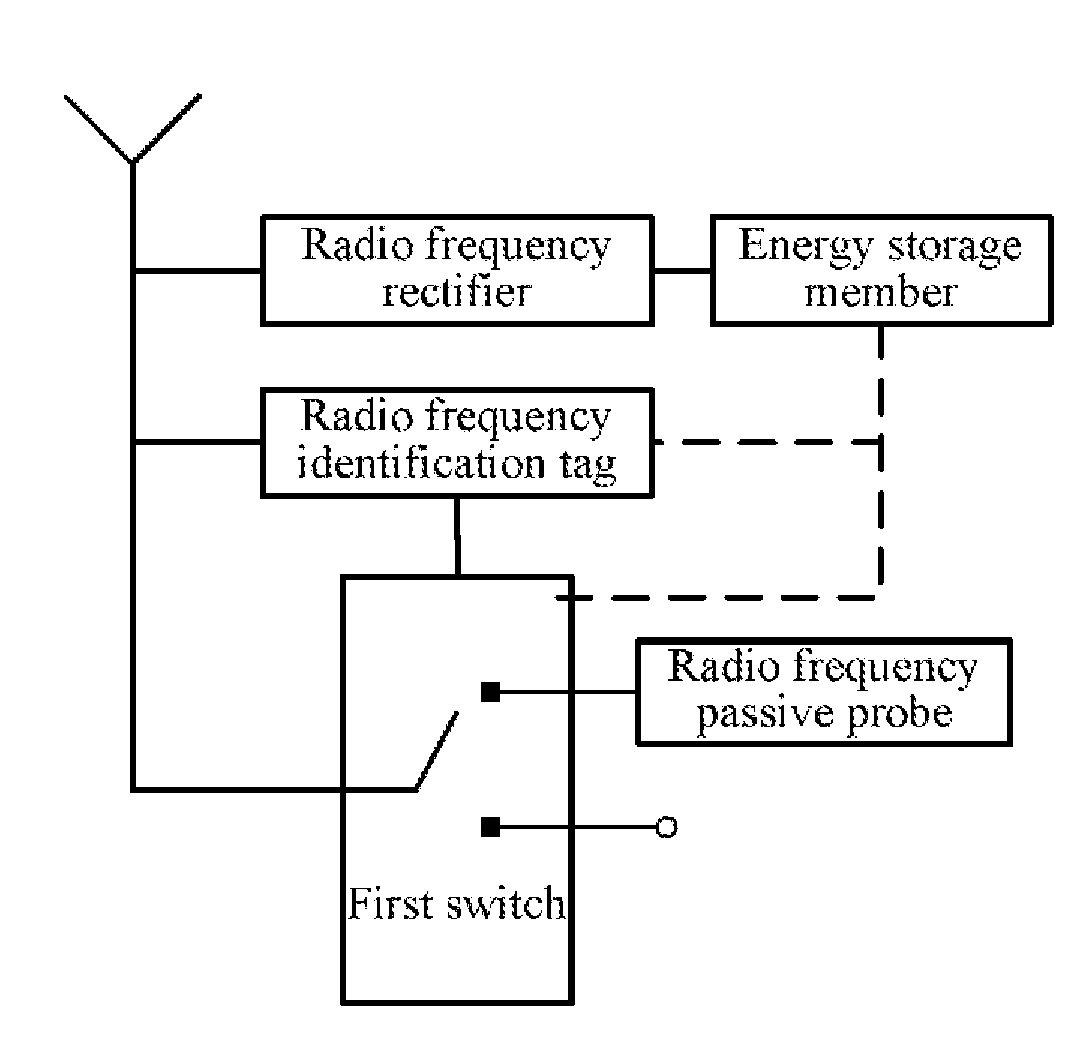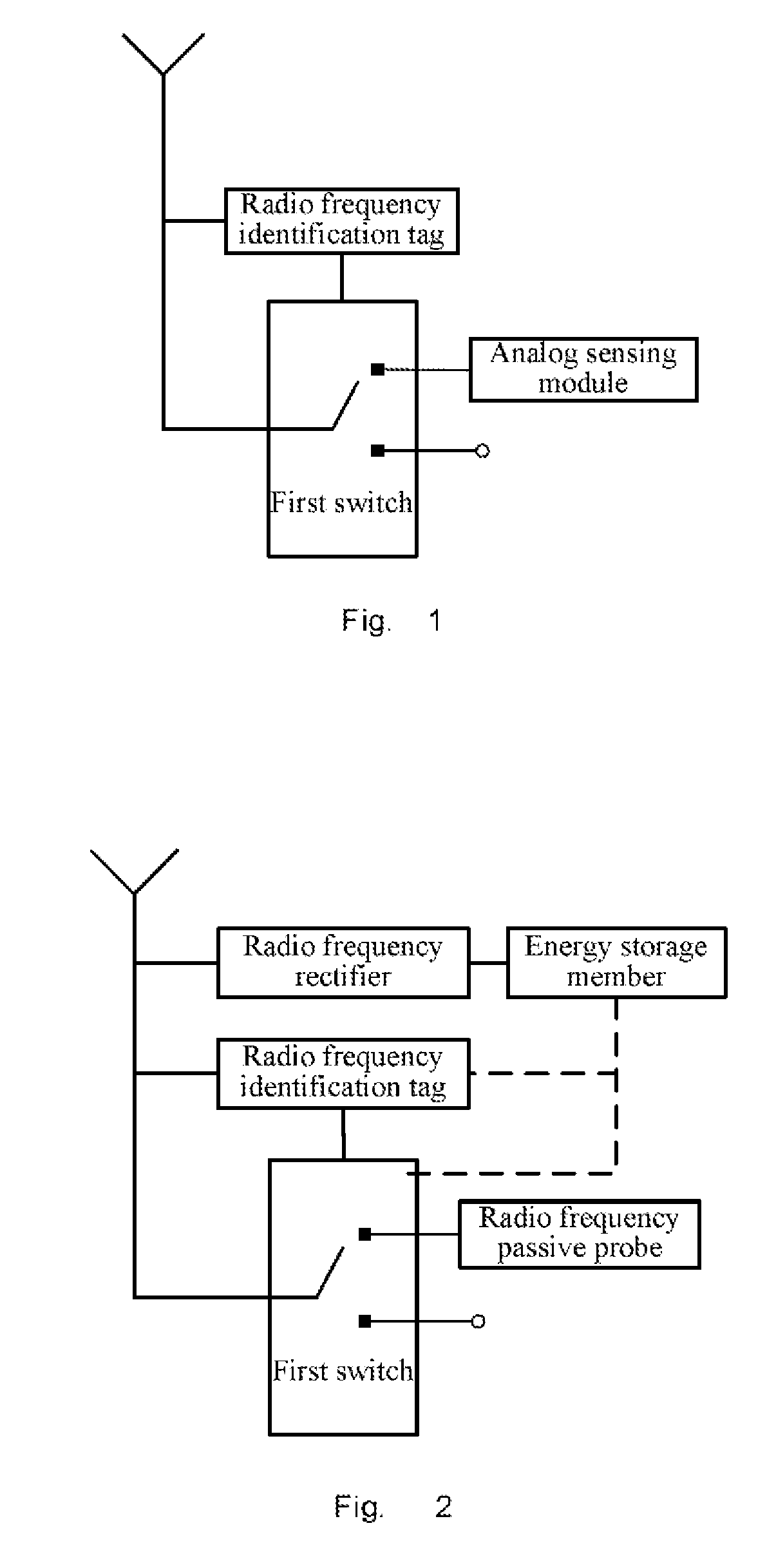Sensor, telemeter, wireless sensor system and use method thereof
a wireless sensor and sensor technology, applied in the field of sensor systems, can solve the problems of address and sensitive variable not being determined, address code needs to be realized in lithography process, and inability to integrate multiple access functions without external power supply, etc., to achieve the effect of expanding the scope of communication and reducing power consumption
- Summary
- Abstract
- Description
- Claims
- Application Information
AI Technical Summary
Benefits of technology
Problems solved by technology
Method used
Image
Examples
first embodiment
[0048]the present invention relates to a sensor, and FIG. 1 is a schematic diagram of the sensor. As shown in FIG. 1, the above sensor comprises a radio frequency identification tag, a first switch and an analog sensing module, wherein:
[0049]The radio frequency identification tag performs a digital communication with a telemeter and judges whether a preset address code matches with a target address code of the telemeter according to a digital communication signal received from the telemeter in a digital communication mode; wherein if not matched, the sensor maintains the digital communication mode, and if matched, the sensor is a target sensor, and the radio frequency identification tag of the target sensor turns on the first switch so that the target sensor enters an analog sensing mode; and in the analog sensing mode, the radio frequency identification tag of the target sensor turns off the first switch after the analog sensing module has reflected an analog sensing signal so that...
third embodiment
[0091]the present invention relates to a telemeter, and FIG. 4 is a schematic diagram of the telemeter. As shown in FIG. 4, the telemeter comprises:
[0092]a second switch that selects an analog transceiver link or a radio frequency identification front end to communicate with a sensor;
[0093]a radio frequency identification front end;
[0094]an analog transceiver link that radiates a target sensor with a radio frequency electromagnetic wave, receives an analog sensing signal from the target sensor and transmits the analog sensing signal to a controller in an analog sensing mode (it can be understood that, in other embodiments of the present invention, the analog transceiver link may not radiate the target sensor with the radio frequency electromagnetic wave and only receives the analog sensing signal from the target sensor);
[0095]a controller that controls the second switch to throw to the radio frequency identification front end and controls the radio frequency identification front end...
sixth embodiment
[0126]the present invention relates to a method of using sensor. FIG. 9 is a flowchart of the method of using sensor.
[0127]The sensor comprises a radio frequency identification tag, a first switch and an analog sensing module, and the first switch turns on or turns off an analog communication between the analog sensing module and the telemeter. As shown in FIG. 9, the use method of sensor comprises the following steps:
[0128]In step 901, the sensor works in a digital communication mode, and the radio frequency identification tag performs a digital communication with a telemeter.
[0129]Then in step 902, the radio frequency identification tag judges whether a preset address code matches with a target address code of the telemeter according to a digital communication signal received from the telemeter; if not matched, then it proceeds to step 906, and if matched, the sensor is a target sensor and then it proceeds to step 903.
[0130]In step 903, the radio frequency identification tag of th...
PUM
 Login to View More
Login to View More Abstract
Description
Claims
Application Information
 Login to View More
Login to View More - R&D
- Intellectual Property
- Life Sciences
- Materials
- Tech Scout
- Unparalleled Data Quality
- Higher Quality Content
- 60% Fewer Hallucinations
Browse by: Latest US Patents, China's latest patents, Technical Efficacy Thesaurus, Application Domain, Technology Topic, Popular Technical Reports.
© 2025 PatSnap. All rights reserved.Legal|Privacy policy|Modern Slavery Act Transparency Statement|Sitemap|About US| Contact US: help@patsnap.com



